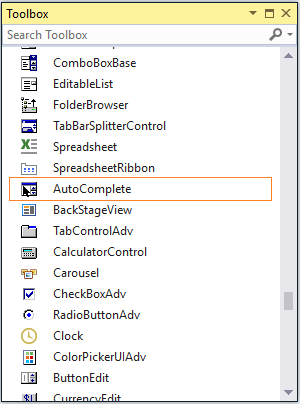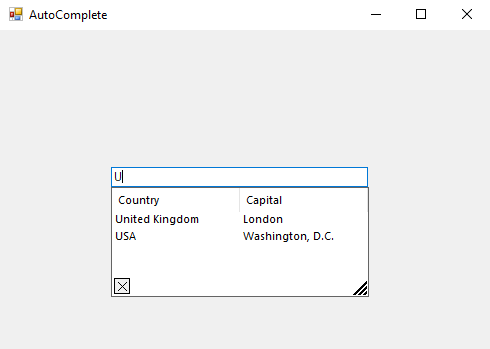Getting Started with Windows Forms AutoComplete
6 Oct 20226 minutes to read
This section provides a quick overview for working with the AutoComplete in Windows Forms.
Assembly deployment
Refer to the Control dependencies section to get the list of assemblies or NuGet package that needs to be added as reference to use the component in any application.
Refer to this documentation to find more details about installing nuget packages in a Windows Forms application.
Creating Application with AutoComplete
In this walk through, users will create WinForms application that contains AutoComplete control.
Creating the Project
Create new Windows Forms Project in Visual Studio to display AutoComplete control.
Adding control via designer
AutoComplete control can be added to the application by dragging it from Toolbox and dropping it in Designer. The required assembly references will be added automatically.


Adding control in code
-
Create a new Windows Forms application in Visual Studio. Add the following required assembly references:
- Syncfusion.Grid.Base
- Syncfusion.Grid.Windows
- Syncfusion.Shared.Base
- Syncfusion.Shared.Windows
- Syncfusion.SpellChecker.Base
- Syncfusion.Tools.Base
- Syncfusion.Tools.Windows
-
Add the required namespace and create an instance for AutoComplete and TextBox controls.
Using Syncfusion.Windows.Forms.Tools public Form1() { InitializeComponent(); AutoComplete autoComplete1 = new AutoComplete(); TextBox textBox1 = new TextBox(); this.Controls.Add(textBox1); }Imports Syncfusion.Windows.Forms.Tools Public Sub New() InitializeComponent() Dim autoComplete1 As AutoComplete = New AutoComplete() Dim textBox1 As TextBox = New TextBox() Me.Controls.Add(textBox1) End Sub
Enable AutoComplete functionality for TextBox control
Enabling via designer
Set the AutoComplete on autoComplete1 property as AutoSuggest using the drop-down provided in the TextBox properties dialog window. The Default value is Disabled.

Enabling via Code
Use the SetAutoComplete method to add the AutoComplete component with the TextBox control.
public Form1()
{
InitializeComponent();
AutoComplete autoComplete1 = new AutoComplete();
TextBox textBox1 = new TextBox();
autoComplete1.SetAutoComplete(textBox1, AutoCompleteModes.AutoSuggest);
this.Controls.Add(textBox1);
}Public Sub New()
InitializeComponent()
Dim autoComplete1 As AutoComplete = New AutoComplete()
Dim textBox1 As TextBox = New TextBox()
autoComplete1.SetAutoComplete(textBox1, AutoCompleteModes.AutoSuggest)
Me.Controls.Add(textBox1)
End SubCreating Datasource for Sample Application
The AutoComplete component supports variety of data sources such as DataTables, DataSets, or any component that implement interfaces like IList, IBindingList, ITypedList, or IListSource. For assigning data source to AutoComplete, use the DataSource property.
private void Form1_Load(object sender, EventArgs e)
{
//Create a data table
DataTable dt = new DataTable("Table1");
dt.Columns.Add("Country");
dt.Columns.Add("Capital");
// Create a data set
DataSet ds = new DataSet();
ds.Tables.Add(dt);
dt.Rows.Add(new string[] { "United Kingdom ", "London" });
dt.Rows.Add(new string[] { "USA", "Washington, D.C." });
dt.Rows.Add(new string[] { "Brazil", "Brasilia" });
dt.Rows.Add(new string[] { "France", "Paris" });
dt.Rows.Add(new string[] { "Russia", "Moscow" });
dt.Rows.Add(new string[] { "India", "Delhi" });
DataView view = new DataView(dt);
// Setting data source to AutoComplete
this.autoComplete1.DataSource = view;
}Private Sub Form1_Load(ByVal sender As Object, ByVal e As EventArgs)
'Create dataTable
Dim dt As DataTable = New DataTable("Table1")
dt.Columns.Add("Country")
dt.Columns.Add("Capital")
'Create a Data Set
Dim ds As DataSet = New DataSet()
ds.Tables.Add(dt)
dt.Rows.Add(New String() {"United Kingdom ", "London"})
dt.Rows.Add(New String() {"USA", "Washington, D.C."})
dt.Rows.Add(New String() {"Brazil", "Brasilia"})
dt.Rows.Add(New String() {"France", "Paris"})
dt.Rows.Add(New String() {"Russia", "Moscow"})
dt.Rows.Add(New String() {"India", "Delhi"})
Dim view As DataView = New DataView(dt)
' setting datasource to autocomplete
Me.autoComplete1.DataSource = view
End Sub